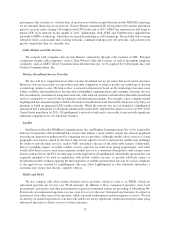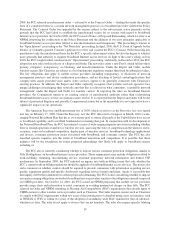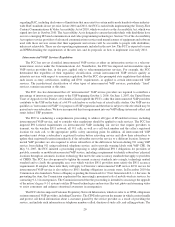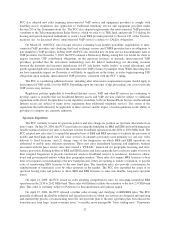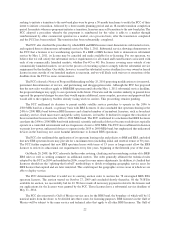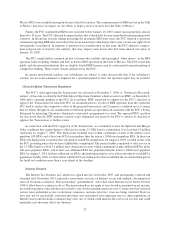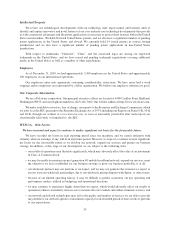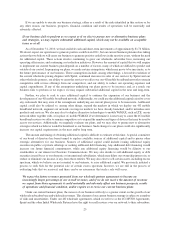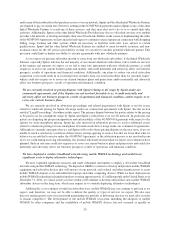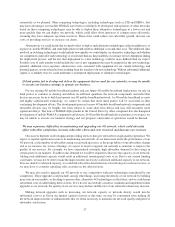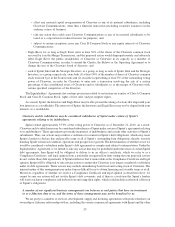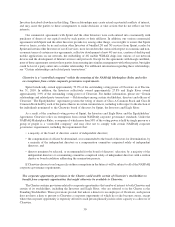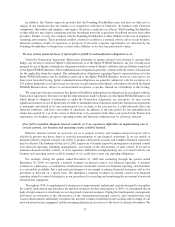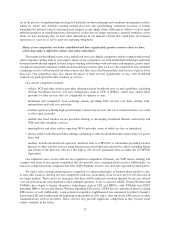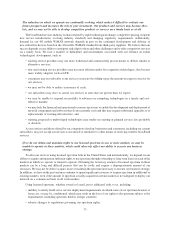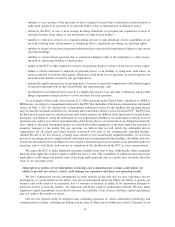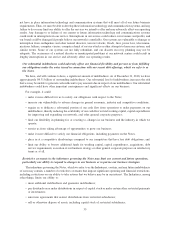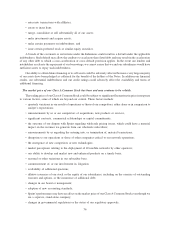Clearwire 2010 Annual Report Download - page 32
Download and view the complete annual report
Please find page 32 of the 2010 Clearwire annual report below. You can navigate through the pages in the report by either clicking on the pages listed below, or by using the keyword search tool below to find specific information within the annual report.extensively as we planned. Other competing technologies, including technologies such as LTE and HSPA+, that
may have advantages over mobile WiMAX, have been or will likely be developed, and operators of other networks
based on those competing technologies may be able to deploy these alternative technologies at a lower cost and
more quickly than we can deploy our network, which could allow those operators to compete more effectively,
assuming they have adequate spectrum resources. These risks could reduce our subscriber growth, increase our
costs of providing services or increase our churn.
Alternatively, we could decide that we need to elect to deploy such alternative technologies, either in addition to, or
in place of, mobile WiMAX, and such deployment would result in additional costs and risks to us. The additional risks
involved in switching technologies would include how quickly we could deploy an alternative technology and whether
our competitors could offer such technology at a faster rate than us, the possibility of customer service disruptions during
the deployment process, and the fact that deployment to a new technology could be more difficult than we expect.
Possible costs of such transfer would include the cost of new equipment that may be required for the new technology,
potential additional tower expenses, obsolescence costs associated with equipment for our current technology, and
potential impacts on our subscriber base resulting from the transfer to the new technology. Without substantial additional
capital, it is unlikely that we could undertake a widespread deployment of alternative technologies.
If third parties fail to develop and deliver the equipment that we need for our networks, we may be unable
to execute our business strategy or operate our business.
For our existing 4G mobile broadband markets and any future 4G mobile broadband deployment, we rely on
third parties to continue to develop and deliver in sufficient quantities the network components and subscriber
devices necessary for us to build and operate our 4G mobile broadband network. As 4G mobile broadband is a new
and highly sophisticated technology, we cannot be certain that these third parties will be successful in their
continuing development efforts. The development process for new 4G mobile broadband network components and
subscriber devices may be lengthy, has been subject to some short-term delays and may still encounter more
significant delays. The lack of WiMAX deployments in the United States by other companies has also hampered
development of mobile WiMAX components and devices. If 4G mobile broadband fails to perform as we expect, we
may be unable to execute our business strategy and our prospects and results of operations would be harmed.
We may experience difficulties in maintaining and upgrading our 4G network, which could adversely
affect subscriber satisfaction, increase subscriber churn and costs incurred, and decrease our revenues.
Our success depends on developing and providing services that give subscribers a high quality experience. We
expect to expend significant resources in maintaining our network. As we learn more about the performance of our
4G network, as the number of subscribers using our network increases, as the usage habits of our subscribers change
and as we increase our service offerings, we expect to need to upgrade our network to maintain or improve the
quality of our services. For example, we have experienced extremely high subscriber demand for data usage in
certain parts of our markets. To address this demand we would be required to increase the capacity of our network.
Adding such additional capacity would result in additional, unanticipated costs to us. Due to our current funding
constraints, we may not be able to make the improvements necessary to add such additional capacity to our network.
If we are unable to add such capacity, we could risk subscriber dissatisfaction or loss from poor customer service, or
we may have to consider curtailing sales activities in the affected areas.
We may also need to upgrade our 4G network to stay competitive with new technologies introduced by our
competitors. These upgrades could include, among other things, increasing the density of our network by building
more sites in our markets, or deciding to pursue other, alternative 4G technologies in the future, and we could incur
substantial costs in undertaking these actions. If we do not successfully construct, maintain and implement future
upgrades to our network, the quality of our services may decline and the rate of our subscriber churn may increase.
Making network upgrades such as increasing our network capacity or network density would involve
substantial costs to us Given our limited capital resources at this time, we may be constrained from making all
the network improvements or enhancements that we deem necessary to maintain our network quality and preserve
subscriber satisfaction.
27


